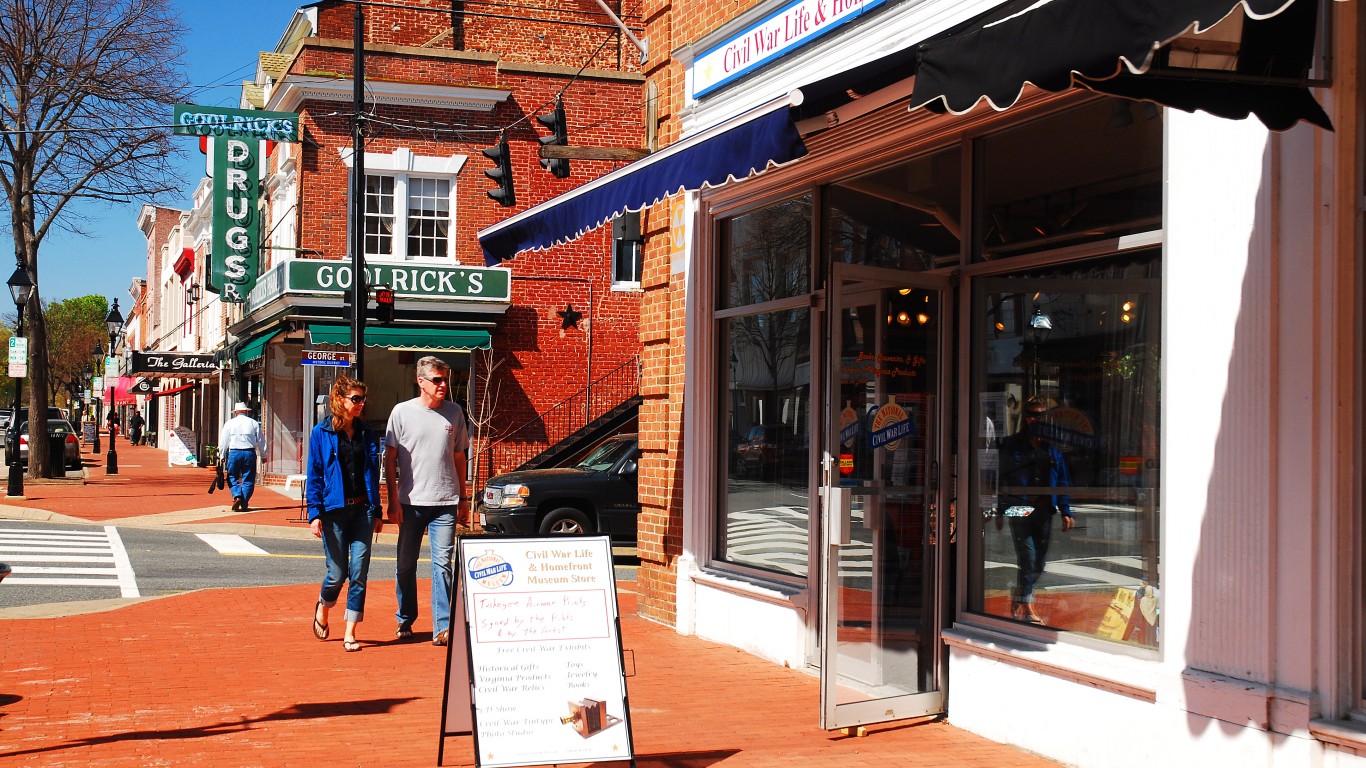The number of retired baby boomers increased by 3.2 million in 2020 compared to 2019, according to Pew Research Center, the largest increase since 2011, when the oldest members of the generation first hit retirement age. Americans reaching retirement may seek a place where they can spend their golden years in good health. Nationwide, the health and well-being of older Americans varies considerably from state to state.
In order to determine the best states for a healthy retirement, 24/7 Tempo created an index using 17 health indicators for Americans 65 and older from the Centers for Disease Control and Prevention’s Healthy Aging Program.
In order to stay healthy in older age, it is important that people eat a healthy diet, avoid unhealthy habits like smoking, and get preventive medical care like vaccinations and disease screenings. Yet it can be difficult for some — especially those on a fixed income — to afford medical care. It is important that retirees have a good idea of what their cost of living will be so they can aim to save enough to avoid financial hardship. This is what it costs to retire in every state.
2020 introduced a new health concern for older Americans — the COVID-19 pandemic. The novel coronavirus is more likely to cause severe, even fatal disease, in older people. State and local leaders have therefore prioritized older residents to receive COVID-19 vaccinations. However, not every place has proven equally adept at getting their vaccine supply into the arms of those who need it. These are the states doing the best job rolling out the vaccine.

50. Alaska
> Population: 731,545
> Pct. of population 65+: 12.4% — 2nd lowest
> Disability, 65+: 45.2% — 16th highest
> Older adults who don’t exercise: 25.4% — 5th lowest
> 2 doses of COVID-19 vaccine administered, Mar 2: 13.7% — the highest
> Flu vaccine in the past year, 65+: 49.0% — 9th lowest
> Primary care physicians: 91 per 100,000 — 6th most
> Avg. retirement income: $43,642 — the highest
Alaska ranks as the worst state for a healthy retirement. With retirees often searching for a warm place to spend their golden years, Alaska is not a retirement destination. Just 12.4% of state residents are 65 and older, the second lowest share of any U.S. state.
Many Alaskans live in remote locations, making access to regular medical care a challenge. Both older men and older women are less likely to be up to date with some clinical preventive services, such as cholesterol screenings, colonoscopies, and mammograms. This may also be due to the financial struggles many older people in Alaska face, as 8.1% of state households with residents age 65 and older rely on public assistance income. This is the highest share of any state and more than four times higher the nationwide rate of 1.8%.

49. New Mexico
> Population: 2,096,829
> Pct. of population 65+: 18.0% — 12th highest
> Disability, 65+: 44.2% — 20th highest
> Older adults who don’t exercise: 29.6% — 15th lowest
> 2 doses of COVID-19 vaccine administered, Mar 2: 11.9% — 2nd highest
> Flu vaccine in the past year, 65+: 53.2% — 22nd lowest
> Primary care physicians: 75 per 100,000 — 22nd fewest
> Avg. retirement income: $31,487 — 15th highest
Older New Mexico residents are among the least likely to receive screening deemed essential by the CDC as well as be up-to-date on their vaccinations. For example, 63.0% of older women have received a mammogram within the last two years, the lowest share in the U.S. Also, 32.5% of older adults have not received regular screenings for colorectal cancer between 2008 and 2018, the second highest share of all states.
Income and health are often closely linked. About 13.5% of state residents 65 and over live below the poverty level, the highest share nationwide. For households 65 and older, 11.1% receive SNAP benefits, the seventh highest hare in the U.S.
48. Louisiana
> Population: 4,648,794
> Pct. of population 65+: 16.0% — 11th lowest
> Disability, 65+: 49.0% — 8th highest
> Older adults who don’t exercise: 38.9% — 5th highest
> 2 doses of COVID-19 vaccine administered, Mar 2: 8.3% — 23rd highest
> Flu vaccine in the past year, 65+: 45.7% — 4th lowest
> Primary care physicians: 67 per 100,000 — 14th fewest
> Avg. retirement income: $27,605 — 24th lowest
Older Louisiana residents are more likely to struggle with certain health problems than older Americans in the majority of states. Some 49.0% of the 65 and older population in the state has a disability, the eighth highest share of all states. Having a disability may have a negative effect on a person’s mental health. About 8.9% of older Louisianans report experiencing frequent mental distress, one of the highest shares nationwide.
Older residents in the state are more likely than older residents of all but two states to incur injuries from falling. About 12.8% of the 65 and older population in Louisiana received an injury from falling in the last year, the third largest share of all states. Nationwide, 10.2% of older Americans were injured due to a fall.

47. Texas
> Population: 28,995,881
> Pct. of population 65+: 12.9% — 3rd lowest
> Disability, 65+: 49.9% — 6th highest
> Older adults who don’t exercise: 36.0% — 12th highest
> 2 doses of COVID-19 vaccine administered, Mar 2: 7.2% — 11th lowest
> Flu vaccine in the past year, 65+: 45.2% — 2nd lowest
> Primary care physicians: 61 per 100,000 — 4th fewest
> Avg. retirement income: $30,444 — 19th highest
Older residents in Texas are among the least likely in the country to receive their recommended preventive care. Only 30.9% of older men and 31.3% of older women are up-to-date on the CDC’s recommended set of clinical preventive services, the lowest and second lowest shares in the country, respectively. In addition, only 70.8% of all older adults received regular tests for colorectal cancer, well below the national average of 76.3%.
Several health outcomes contribute to Texas’ low ranking on this list. Older Texas residents were injured more from falls than older Americans in any other state. Some 13.2% of older residents in the state sustained an injury from a fall in 2018, the highest share nationwide. Those age 65 and older in Texas are more likely to be obese than older people in the rest of the country. About 35.6% of those 65 and older in the state are obese, the highest share among all states. Obesity predisposes to disability and decreased physical functioning.

46. West Virginia
> Population: 1,792,147
> Pct. of population 65+: 20.5% — 3rd highest
> Disability, 65+: 61.1% — the highest
> Older adults who don’t exercise: 37.9% — 7th highest
> 2 doses of COVID-19 vaccine administered, Mar 2: 11.7% — 3rd highest
> Flu vaccine in the past year, 65+: 63.5% — 4th highest
> Primary care physicians: 78 per 100,000 — 22nd most
> Avg. retirement income: $22,242 — 2nd lowest
West Virginia ranks as one of the worst states for a healthy retirement for a number of reasons. More than 60% of state residents 65 and older have a disability, by far the highest share of any state. For context, 44% of Americans 65 and older report having a disability.
West Virginia older adults have some of the worst health indicators of any state. More than half of residents 65 and older have lost more than five teeth due to decay or gum disease, one of just two states where this is the case. Older residents often do not feel well, reporting an average of 7.3 physically unhealthy days per month, much more than in any other state.

45. Kentucky
> Population: 4,467,673
> Pct. of population 65+: 16.9% — 24th lowest
> Disability, 65+: 56.8% — 3rd highest
> Older adults who don’t exercise: 45.6% — the highest
> 2 doses of COVID-19 vaccine administered, Mar 2: 7.9% — 21st lowest
> Flu vaccine in the past year, 65+: 59.4% — 10th highest
> Primary care physicians: 66 per 100,000 — 8th fewest
> Avg. retirement income: $26,310 — 15th lowest
The 65 and older population in Kentucky reports some of the least healthy behaviors among this population in any state. The smoking rate among older Kentucky adults of 13.1% is the second highest nationwide, and 45.6% of 65 and older residents do not exercise on a regular basis, the highest share of all states. Both of these unhealthy behaviors likely contribute to state older adults reporting feeling physically unhealthy for more than six days a month, more than all but two other states.
Mental health is just as significant as physical health and can greatly affect daily routine. In Kentucky, 19.4% of older residents have been diagnosed with depression, the third highest share in the U.S.

44. Nevada
> Population: 3,080,156
> Pct. of population 65+: 16.2% — 17th lowest
> Disability, 65+: 48.5% — 11th highest
> Older adults who don’t exercise: 32.9% — 19th highest
> 2 doses of COVID-19 vaccine administered, Mar 2: 8.1% — 23rd lowest
> Flu vaccine in the past year, 65+: 59.5% — 9th highest
> Primary care physicians: 57 per 100,000 — 2nd fewest
> Avg. retirement income: $34,913 — 7th highest
Nevada residents age 65 and older are among the least likely to eat a healthy diet in the country. Just 28.5% reported eating the recommended daily amount of fruit, and 7.5% said they ate the recommended amount of vegetables — both figures well below the nationwide rates of 34.5% and 13.2%, respectively.
State residents may also struggle to find medical care, as there are just 56.6 primary care physicians per 100,000 Nevada residents — the second lowest concentration among all states, and well below the national concentration of 75.5 per 100,000. Just 70.1% of Nevada residents 65 and older have had a colorectal cancer screening, such as a home stool test, sigmoidoscopy, or colonoscopy in the past decade, a lower share than all but two other states.

43. Mississippi
> Population: 2,976,149
> Pct. of population 65+: 16.4% — 19th lowest
> Disability, 65+: 58.6% — 2nd highest
> Older adults who don’t exercise: 40.6% — 4th highest
> 2 doses of COVID-19 vaccine administered, Mar 2: 7.4% — 13th lowest
> Flu vaccine in the past year, 65+: 60.0% — 6th highest
> Primary care physicians: 53 per 100,000 — the fewest
> Avg. retirement income: $24,987 — 8th lowest
Mississippi ranks as one of the worst states for a healthy retirement, as state residents age 65 and older tend to struggle with their health as well as their finances. The state has the second highest share of 65 and older residents who live in poverty at 13.2%. And the average income for households with retirement income is less than $25,000, compared to $30,512 for the average American household with retirement income.
Lower-income areas tend to have worse health outcomes, and Mississippi is no exception. State residents 65 and older report an average of 6.6 physically unhealthy days per month, more than a full day over the U.S. average. Mississippi has the second lowest life expectancy of all 50 states, at 74.9 years. The U.S. life expectancy is 78.7.

42. Arkansas
> Population: 3,017,804
> Pct. of population 65+: 17.4% — 22nd highest
> Disability, 65+: 49.8% — 7th highest
> Older adults who don’t exercise: 41.3% — 2nd highest
> 2 doses of COVID-19 vaccine administered, Mar 2: 7.8% — 18th lowest
> Flu vaccine in the past year, 65+: 47.6% — 6th lowest
> Primary care physicians: 67 per 100,000 — 12th fewest
> Avg. retirement income: $25,635 — 13th lowest
Arkansas ranks as one of the worst states for a healthy retirement mostly because of the relatively poor physical health of the 65 and older population. Residents of this age group report an average of 6.4 physically unhealthy days per month, the fourth highest average nationwide. Nearly one in two older residents have a disability, one of the highest shares in the U.S.
Leading a healthy lifestyle typically requires regular doctor visits and getting necessary screenings and other preventive care. Only 35.3% of men 65 and older and 33.1% of women 65 and older in Arkansas are up to date on recommended clinical preventive services, the seventh and third lowest shares nationwide, respectively.
41. Tennessee
> Population: 6,829,174
> Pct. of population 65+: 16.7% — 22nd lowest
> Disability, 65+: 52.4% — 5th highest
> Older adults who don’t exercise: 41.1% — 3rd highest
> 2 doses of COVID-19 vaccine administered, Mar 2: 7.1% — 8th lowest
> Flu vaccine in the past year, 65+: 48.1% — 7th lowest
> Primary care physicians: 72 per 100,000 — 18th fewest
> Avg. retirement income: $25,111 — 9th lowest
According to the CDC, nearly one in five deaths in the United States, or 1,300 deaths every day, are caused by smoking cigarettes, and in Tennessee, 13.1% of residents 65 and older smoke often or every day, the second highest share of any state. Smoking can hinder a person’s ability to exercise and be physically fit, and 41.1% of older state residents do not exercise, while 52.4% have a disability, the third and fifth highest shares in the U.S., respectively.
Poor mental health can also reduce quality of life. In Tennessee. 10.3% of 65 and older residents report frequent mental distress, and 18.6% have been diagnosed with depression at some point in their lives. Both rates are among the highest in the country.

40. Indiana
> Population: 6,732,219
> Pct. of population 65+: 16.1% — 13th lowest
> Disability, 65+: 45.6% — 14th highest
> Older adults who don’t exercise: 37.7% — 9th highest
> 2 doses of COVID-19 vaccine administered, Mar 2: 8.8% — 14th highest
> Flu vaccine in the past year, 65+: 46.9% — 5th lowest
> Primary care physicians: 66 per 100,000 — 10th fewest
> Avg. retirement income: $21,582 — the lowest
A number of factors make Indiana a less-than-ideal place to retire. Older state residents are among the least likely to get physical activity and among the most likely to be regular smokers. Fewer than 35% of both men and women 65 and older are up to date on their clinical preventive health services, compared to 39.9% of all American men and 39.0% of all American women in the age group. Indiana has the fifth highest obesity rate among older residents, at 32.8%. Nationwide, just 29.0% of 65 and older adults are considered obese.
These unhealthy behaviors, along with lack of health care and poor health outcomes may be at least partially attributable to the fact that the state has one of the lowest concentrations of primary care physicians in the country, at just 66 per 100,000. Income and health are closely linked. The state’s older residents with retirement income average $21,582 in income each year — dead last in the nation and nearly $9,000 behind the nationwide average.

39. Wyoming
> Population: 578,759
> Pct. of population 65+: 17.1% — 24th highest
> Disability, 65+: 45.5% — 15th highest
> Older adults who don’t exercise: 29.3% — 12th lowest
> 2 doses of COVID-19 vaccine administered, Mar 2: 9.6% — 8th highest
> Flu vaccine in the past year, 65+: 52.9% — 20th lowest
> Primary care physicians: 68 per 100,000 — 15th fewest
> Avg. retirement income: $28,593 — 24th highest
Like in many of the worst states for healthy retirement, Wyoming residents who are 65 and older are less likely to receive preventative screenings. Just 67.4% have been screened for colorectal cancer in the decade between 2008 and 2018, the lowest share of any U.S. state. Among 65 and older women residents, only 65.8% have received a mammogram between 2016 and 2018, the fourth lowest share in the U.S.
Disability in old age is more likely in Wyoming than most other states. Approximately 45.5% of those 65 and older have a disability, compared to 44.0% of the age group nationwide.

38. Oklahoma
> Population: 3,956,971
> Pct. of population 65+: 16.1% — 12th lowest
> Disability, 65+: 54.1% — 4th highest
> Older adults who don’t exercise: 36.2% — 11th highest
> 2 doses of COVID-19 vaccine administered, Mar 2: 10.2% — 6th highest
> Flu vaccine in the past year, 65+: 64.5% — 2nd highest
> Primary care physicians: 62 per 100,000 — 5th fewest
> Avg. retirement income: $24,948 — 7th lowest
Oklahoma’s 65 and older residents are among the least likely to eat a healthy diet. The state has the second lowest rates of older residents who eat the recommended amount of both fruits and vegetables. Oklahoma’s older adults reported an average of 6.2 physically unhealthy days in the last month, one of the 10 highest averages in the country.
The average life expectancy increased in every state from 1980 to 2014. In Oklahoma, it increased the least, by just 3.4%, compared to the 7.2% nationwide. State residents may struggle to receive preventive care as Oklahoma has one of the lowest concentrations of doctors per capita. There are just 62 primary care physicians per 100,000 residents, the fifth lowest rate among states.

37. Montana
> Population: 1,068,778
> Pct. of population 65+: 19.5% — 6th highest
> Disability, 65+: 46.5% — 13th highest
> Older adults who don’t exercise: 29.4% — 13th lowest
> 2 doses of COVID-19 vaccine administered, Mar 2: 8.9% — 12th highest
> Flu vaccine in the past year, 65+: 57.4% — 19th highest
> Primary care physicians: 80 per 100,000 — 17th most
> Avg. retirement income: $26,811 — 21st lowest
Montana’s 65 and older residents do not get screened for colorectal cancer as often as they should, according to doctors. The chances of developing colorectal cancers increases with age, and only 71.7% of adults 65 and over in Montana have been screened for it between 2008 and 2018, the seventh lowest share of all states.
Eating a diet full of fresh produce and minimal processed foods can help keep excess weight off and maintain good health. In Montana, 29.0% of older adults eat enough fruits and 10.1% eat enough vegetables a day. Both shares are among the lowest in the U.S.

36. Alabama
> Population: 4,903,185
> Pct. of population 65+: 17.4% — 20th highest
> Disability, 65+: 48.7% — 10th highest
> Older adults who don’t exercise: 37.9% — 7th highest
> 2 doses of COVID-19 vaccine administered, Mar 2: 6.6% — 3rd lowest
> Flu vaccine in the past year, 65+: 58.0% — 16th highest
> Primary care physicians: 65 per 100,000 — 6th fewest
> Avg. retirement income: $26,549 — 19th lowest
Alabama ranks among the 15 worst states for a healthy retirement largely because state older residents often report feeling mentally and physically unwell. The state’s 65 and older residents report 6.4 physically unhealthy days per month, the fourth highest share in the country and well above the nationwide figure. Alabama also has the fifth highest share of older adults who report frequent mental distress, at 10.0%.
Across the U.S., 8.0% of residents have received both doses of the COVID-19 vaccine. In Alabama, just 6.6% of residents have received both doses, the third lowest share of any state. Residents may struggle to get all kinds of basic medical care as there are just 65 primary care physicians per 100,000 residents, one of the lowest concentrations nationwide.

35. Idaho
> Population: 1,787,065
> Pct. of population 65+: 16.2% — 16th lowest
> Disability, 65+: 43.2% — 25th lowest
> Older adults who don’t exercise: 26.7% — 8th lowest
> 2 doses of COVID-19 vaccine administered, Mar 2: 7.6% — 16th lowest
> Flu vaccine in the past year, 65+: 53.0% — 21st lowest
> Primary care physicians: 66 per 100,000 — 9th fewest
> Avg. retirement income: $25,505 — 12th lowest
Idaho ranks among the 20 worst states for a healthy retirement in large part because the state’s 65 and older residents are less likely to be monitored with certain critical tests than residents of the same age group in most other states. For instance, just 66.4% of 65 and older women in Idaho reported getting a mammogram in the last two years — a lower share than all but five other states. Nationwide, more than 74% of women that age have gotten a mammogram during that time. Also, Idaho has the fourth lowest share of older residents who have had a cholesterol screening in the last five years, at just 94.4%, compared to 97.0% of all Americans in that age group.
Idaho’s 65 and older residents are much more likely to have been injured in a fall. In the past year, 12.2% of the state’s older residents were hurt in a fall, the fifth highest share among all states and 2 full percentage points higher than the share nationwide.
34. New York
> Population: 19,453,561
> Pct. of population 65+: 16.9% — 25th lowest
> Disability, 65+: 44.1% — 21st highest
> Older adults who don’t exercise: 31.1% — 24th lowest
> 2 doses of COVID-19 vaccine administered, Mar 2: 7.8% — 17th lowest
> Flu vaccine in the past year, 65+: 44.8% — the lowest
> Primary care physicians: 82 per 100,000 — 14th most
> Avg. retirement income: $32,779 — 12th highest
New York ranks among the worst in the nation when it comes to taking certain critical steps to ensure 65 and older residents have a healthy retirement. According to 2018 data, the Empire State ranks dead last in the country in the percentage of older adults who got a flu vaccine in the past year, at just 44.8%.
New York also ranks last in the country in terms of the percentage of 65 and older residents with an underlying health condition who have ever gotten a pneumococcal vaccine. Similarly, 39% of older women nationwide are up to date on their clinical preventive services, but in New York, just 29.4% are — the only state in which that figure is below 31%. However, the state does not rank among the very worst states for a healthy retirement in part because older adults tend to have a balanced diet, with one of the highest shares reporting eating the recommended amount of fruits and vegetables.
33. Illinois
> Population: 12,671,821
> Pct. of population 65+: 16.1% — 14th lowest
> Disability, 65+: 42.3% — 21st lowest
> Older adults who don’t exercise: 37.0% — 10th highest
> 2 doses of COVID-19 vaccine administered, Mar 2: 6.7% — 4th lowest
> Flu vaccine in the past year, 65+: 55.4% — 24th highest
> Primary care physicians: 80 per 100,000 — 18th most
> Avg. retirement income: $32,528 — 13th highest
Access to preventive care such as screenings necessary to detect cancer is only slightly worse in Illinois than it is across the country. Approximately 39.2% of men 65 and older are up to date on recommended preventive care procedures, just below the national averages of 39.9%. The share of 65 and older women who are up to date on these services is slightly higher. Older Illinois residents are considerably less likely than older Americans nationwide to receive regular screenings for colorectal cancer — only 70.7% of older Illinois residents do, the fourth lowest rate and compared with the 76.3% of older Americans nationwide who do.
Illinois residents 65 and older are less likely than all Americans of the age group to exercise. About 37.0% do not exercise on a regular basis, the 10th highest share nationwide. Exercising regularly can help reduce the likelihood of developing chronic diseases.

32. South Dakota
> Population: 884,659
> Pct. of population 65+: 17.4% — 21st highest
> Disability, 65+: 44.5% — 19th highest
> Older adults who don’t exercise: 32.3% — 21st highest
> 2 doses of COVID-19 vaccine administered, Mar 2: 10.9% — 4th highest
> Flu vaccine in the past year, 65+: 51.1% — 14th lowest
> Primary care physicians: 76 per 100,000 — 24th fewest
> Avg. retirement income: $23,799 — 4th lowest
Retirement-age South Dakota residents may be more likely than most retirement-age Americans to struggle financially. The state’s average annual retirement income among households 65 and older is just $23,799, well below the $30,512 average retirement income nationwide. Higher-income Americans are more likely to make regular doctor visits, receive preventive care, and be healthier.
Access to screenings necessary to detect cancer in South Dakota is worse than it is across the country. About 37.1% of men and 38.7% of women 65 and older are up-to-date on recommended preventive care procedures, each below the respective national averages of 39.9% and 39.0%.

31. Ohio
> Population: 11,689,100
> Pct. of population 65+: 17.5% — 19th highest
> Disability, 65+: 44.9% — 17th highest
> Older adults who don’t exercise: 35.6% — 13th highest
> 2 doses of COVID-19 vaccine administered, Mar 2: 8.1% — 25th lowest
> Flu vaccine in the past year, 65+: 55.8% — 23rd highest
> Primary care physicians: 76 per 100,000 — 25th most
> Avg. retirement income: $27,260 — 22nd lowest
Ohio ranks below most states as a place for a healthy retirement. The state has among the top 10 highest shares of 65 and older adults who smoke regularly, at 10.7%. Nationwide, fewer than 9% of older adults smoke regularly. Ohio also has one of the highest obesity rates in 65 and older adults, at 32.7%, compared to the national rate of 29%.
However, Ohio also performs well in a number of health measures. More than 42% of both men and women 65 and older are up to date with certain preventive clinical services like disease screenings and immunizations. Nationwide, 39.9% of men 65 and older and 39.0% of women are up to date on these services.

30. Arizona
> Population: 7,278,717
> Pct. of population 65+: 18.0% — 13th highest
> Disability, 65+: 40.7% — 15th lowest
> Older adults who don’t exercise: 29.8% — 16th lowest
> 2 doses of COVID-19 vaccine administered, Mar 2: 8.2% — 25th highest
> Flu vaccine in the past year, 65+: 50.6% — 11th lowest
> Primary care physicians: 66 per 100,000 — 11th fewest
> Avg. retirement income: $30,168 — 20th highest
Leading a healthy lifestyle typically requires regular doctor visits. Older adults in Arizona may struggle to get regular checkups as the state has one of the lowest concentrations of health professionals per capita. There are 66 primary care physicians per 100,000 residents, the 10th lowest concentration among all states.
Staying healthy at an older age also requires getting necessary screenings and other preventive care. People 65 and older in the state are not as likely to get the preventive care they need compared to older adults nationwide. For example, 50.6% of older residents received their flu shot in 2018, the 10th lowest share among all states. Additionally, only 36.1% of older women are up to date with the recommended clinical preventive services, the eighth lowest share in the nation.

29. Georgia
> Population: 10,617,423
> Pct. of population 65+: 14.3% — 4th lowest
> Disability, 65+: 46.9% — 12th highest
> Older adults who don’t exercise: 33.5% — 18th highest
> 2 doses of COVID-19 vaccine administered, Mar 2: 7.1% — 9th lowest
> Flu vaccine in the past year, 65+: 52.6% — 17th lowest
> Primary care physicians: 65 per 100,000 — 7th fewest
> Avg. retirement income: $30,990 — 17th highest
Georgia’s older adults are more likely to feel physically and mentally unwell than the typical American aged 65 and older. Of the state’s older residents, 9.5% reported feeling frequent mental distress — well above the 7.9% share nationwide and the seventh highest share of all states. State residents 65 and older also reported 5.9 physically unhealthy days in the last month, 12th highest among states.
Georgia ranks towards the middle of states as a good place for a healthy retirement in part because 65 and older state residents are more likely to receive certain disease screenings than residents of the age group in most other states. Four out of five 65 and older women have gotten a mammogram in the last two years, the second highest share among all states. Georgia also has the ninth highest rate of older adults who have been checked for colorectal cancer in the last decade, at 78.3%.

28. North Dakota
> Population: 762,062
> Pct. of population 65+: 15.8% — 7th lowest
> Disability, 65+: 44.8% — 18th highest
> Older adults who don’t exercise: 31.0% — 22nd lowest
> 2 doses of COVID-19 vaccine administered, Mar 2: 10.8% — 5th highest
> Flu vaccine in the past year, 65+: 57.5% — 18th highest
> Primary care physicians: 77 per 100,000 — 24th most
> Avg. retirement income: $26,286 — 14th lowest
In North Dakota, older adults are less likely to feel either physically or mentally unwell than the typical American 65 and older. Just 5.1% of older state residents reported feeling frequent mental distress, the third lowest percentage of any state and well below the 7.9% rate nationwide. Older residents also reported 4.9 physically unhealthy per month, compared to 5.5 days per month nationwide.
In spite of this, North Dakota still ranks in the bottom half of better states for a healthy retirement. This is in part because 34.4% of older adults in the state are considered obese — the second highest share and well above the national obesity rate for the age group of 29.0%.

27. Wisconsin
> Population: 5,822,434
> Pct. of population 65+: 17.5% — 18th highest
> Disability, 65+: 34.6% — 2nd lowest
> Older adults who don’t exercise: 31.0% — 22nd lowest
> 2 doses of COVID-19 vaccine administered, Mar 2: 9.0% — 10th highest
> Flu vaccine in the past year, 65+: 45.4% — 3rd lowest
> Primary care physicians: 79 per 100,000 — 20th most
> Avg. retirement income: $26,744 — 20th lowest
Wisconsin’s residents 65 and older are among the most likely not to get the flu shot. About 45.4% of the state’s older adults report receiving the flu vaccine, the third lowest proportion of all states and well below the comparable national share of less than 54.0%. Accessing critical preventive care may also be a problem in the state for older residents. Only 36.5% of Wisconsin 65 and older men and 33.6% of 65 and older women are up to date with the CDC’s recommended set of clinical preventive services. Both shares are among the lowest of all states.
Older adults in Wisconsin are more likely than the typical older American to struggle financially during retirement. The average retirement income in the U.S. is $30,512 a year. In Wisconsin, it is $26,744.

26. Michigan
> Population: 9,986,857
> Pct. of population 65+: 17.7% — 14th highest
> Disability, 65+: 41.3% — 19th lowest
> Older adults who don’t exercise: 30.8% — 20th lowest
> 2 doses of COVID-19 vaccine administered, Mar 2: 8.6% — 17th highest
> Flu vaccine in the past year, 65+: 51.9% — 15th lowest
> Primary care physicians: 78 per 100,000 — 21st most
> Avg. retirement income: $26,510 — 18th lowest
The average life expectancy at birth in Michigan is about 78 years, just below the national average life expectancy at birth of about 79 years. As in other states with a lower life expectancy, older adults in Michigan exhibit several other poor health outcomes. Older adults in Michigan are more likely to be obese than older adults in most other states. About 32.5% of residents 65 and older are obese, the 10th highest share among all states.
A relatively large share of Michigan’s older population struggles with mental health issues. The percentage of residents 65 and over who have struggled or currently struggle with depression, at 16.6%, is the 12th highest share among states. Nationwide, 14.4% of older Americans have been diagnosed with depression.

25. Missouri
> Population: 6,137,428
> Pct. of population 65+: 17.2% — 23rd highest
> Disability, 65+: 49.0% — 8th highest
> Older adults who don’t exercise: 33.9% — 16th highest
> 2 doses of COVID-19 vaccine administered, Mar 2: 7.6% — 15th lowest
> Flu vaccine in the past year, 65+: 61.2% — 5th highest
> Primary care physicians: 70 per 100,000 — 16th fewest
> Avg. retirement income: $25,482 — 11th lowest
Missouri ranks right in the middle of U.S. states as a place for a healthy retirement. The state performs well on a number of key health indicators, but poorly on others. For instance, 65 and older Missouri residents are among the most likely in the country to have received preventive care with 43.4% of older men and 47.8% of older women up to date on clinical preventive services like disease screenings and immunizations. This is much higher than the national rates of 39.9% of men and 39.0% of women.
However, nearly half of Missouri’s older adults, 49.0%, report having a disability — the eighth highest share in the country and 5 percentage points higher than the comparable national rate. The state also has the 15th highest obesity rate among 65 and older adults, at 31.6%.

24. Florida
> Population: 21,477,737
> Pct. of population 65+: 20.9% — 2nd highest
> Disability, 65+: 43.3% — 24th highest
> Older adults who don’t exercise: 31.1% — 24th lowest
> 2 doses of COVID-19 vaccine administered, Mar 2: 8.4% — 22nd highest
> Flu vaccine in the past year, 65+: 52.8% — 19th lowest
> Primary care physicians: 73 per 100,000 — 20th fewest
> Avg. retirement income: $31,405 — 16th highest
With the second largest proportion of residents 65 and over, Florida is one of the country’s most popular retirement destinations. But the state’s older population is not among the healthiest. Older Florida residents are less likely to get a flu vaccination and less likely to regularly engage in physical activity than the typical older American. Income and health are often closely linked, and 10.7% of state residents 65 and over live below the poverty level, the sixth highest poverty rate among the age group nationwide.
The 65 and older population in Florida is ahead of most other states when it comes to receiving cancer screenings. Some 79.9% of people 65 and older receive regular tests for colorectal cancer, the fourth largest share of all states.

23. Oregon
> Population: 4,217,737
> Pct. of population 65+: 18.2% — 10th highest
> Disability, 65+: 43.3% — 24th highest
> Older adults who don’t exercise: 26.1% — 6th lowest
> 2 doses of COVID-19 vaccine administered, Mar 2: 8.9% — 11th highest
> Flu vaccine in the past year, 65+: 49.2% — 10th lowest
> Primary care physicians: 94 per 100,000 — 5th most
> Avg. retirement income: $30,446 — 18th highest
Older Oregon residents are among the most likely to eat healthily and exercise. Some 17.8% of 65 and over state residents eat three or more servings of vegetables a day, and 41.1% eat two or more fruits a day, the third and second highest share of all states, respectively. Older Oregon residents are the sixth most likely to report regular exercise routines. About 73.9% report regular physical activity, compared to the national average of 67.7%.
Yet that same population is among the most likely in the country to struggle with mental health. For example, just 19.2% of 65 and older adults in the state have struggled or are currently struggling with depression, the fourth highest rate in the U.S., compared to a nationwide share of 14.4%.

22. Utah
> Population: 3,205,958
> Pct. of population 65+: 11.4% — the lowest
> Disability, 65+: 41.8% — 20th lowest
> Older adults who don’t exercise: 26.3% — 7th lowest
> 2 doses of COVID-19 vaccine administered, Mar 2: 6.0% — 2nd lowest
> Flu vaccine in the past year, 65+: 52.0% — 16th lowest
> Primary care physicians: 58 per 100,000 — 3rd fewest
> Avg. retirement income: $29,406 — 21st highest
Utah ranks among the top 25 states for a healthy retirement, partially because of older residents’ healthy habits. Older residents are less likely to smoke and more likely to exercise regularly compared to most states. In fact, only 5.5% of 65 and older residents smoke, the lowest share of any state. These healthy behaviors may have contributed to the lower prevalence of older adults with disability. About 41.8% of those 65 and older Utah residents have a disability, less than the 44.0% of older adults nationwide.
While 96.2% of older state residents received regular cholesterol screenings â in line with the national rate — the frequency of other checks among Utah’s older population has room for improvement, especially among women. About 68.7% of women 65 and older have received a mammogram between 2016 and 2018, one of the lowest share in the U.S.

21. Massachusetts
> Population: 6,892,503
> Pct. of population 65+: 17.0% — 25th highest
> Disability, 65+: 41.1% — 18th lowest
> Older adults who don’t exercise: 31.3% — 25th highest
> 2 doses of COVID-19 vaccine administered, Mar 2: 7.9% — 20th lowest
> Flu vaccine in the past year, 65+: 54.5% — 24th lowest
> Primary care physicians: 103 per 100,000 — 3rd most
> Avg. retirement income: $34,989 — 6th highest
Retirement-age adults in Massachusetts tend to have relatively healthy diets. Some 14.7% of older adults in the state eat three or more servings of vegetables each day, compared to 13.2% of older adults nationwide. Also, 36.7% of older adults in the state eat two or more servings of fruit daily, compared to 34.5% nationwide. Healthy eating habits may be a factor in the state’s lower than average 26.2% obesity rate among 65 and older residents, the eighth lowest share in the U.S.
Leading a healthy lifestyle typically requires regular doctor visits. There are 103 primary care physicians per 100,000 residents in Massachusetts, the third highest concentration and well above the national average of 75 per 100,000 people.

20. South Carolina
> Population: 5,148,714
> Pct. of population 65+: 18.2% — 11th highest
> Disability, 65+: 43.9% — 22nd highest
> Older adults who don’t exercise: 33.8% — 17th highest
> 2 doses of COVID-19 vaccine administered, Mar 2: 6.9% — 5th lowest
> Flu vaccine in the past year, 65+: 58.4% — 13th highest
> Primary care physicians: 67 per 100,000 — 13th fewest
> Avg. retirement income: $28,450 — 25th highest
South Carolina has some of the highest shares of residents 65 and older who are up to date on their screenings and vaccinations, but the state also has higher shares of older adults reporting unhealthy behaviors. The state has some of the lowest shares of older residents who eat enough fruits and vegetables every day and who are likely to exercise regularly.
Mental health is just as important as physical health when it comes to living a long healthy life, and about 15.7% of South Carolina’s residents 65 and older have struggled or currently struggle with depression, compared to 14.4% of older Americans who have depression nationwide.

19. Kansas
> Population: 2,913,314
> Pct. of population 65+: 16.4% — 20th lowest
> Disability, 65+: 42.5% — 23rd lowest
> Older adults who don’t exercise: 31.2% — 25th lowest
> 2 doses of COVID-19 vaccine administered, Mar 2: 7.0% — 7th lowest
> Flu vaccine in the past year, 65+: 56.3% — 21st highest
> Primary care physicians: 77 per 100,000 — 23rd most
> Avg. retirement income: $24,301 — 5th lowest
Getting the flu at an older age can be life-threatening, and in Kansas, about 56.3% of 65 and older residents got their flu shot in 2018, above the national share of 54.0%. Older Kansas residents are also slightly less likely to smoke and lead a sedentary lifestyle than older Americans nationwide. About 8.3% of adults 65 and over smoke often if not every day, below the comparable national smoking rate of 8.9%. And 31.2% of older residents do not exercise, compared to 32.3% of Americans 65 and older across the U.S.
Kansas residents 65 and older are less likely to struggle with mental health than those of the age group nationwide. About 7.3% of older adults in the state reported experiencing frequent mental distress in 2018, compared to 7.9% of older adults in the U.S. as a whole.

18. Rhode Island
> Population: 1,059,361
> Pct. of population 65+: 17.7% — 15th highest
> Disability, 65+: 40.2% — 13th lowest
> Older adults who don’t exercise: 35.5% — 14th highest
> 2 doses of COVID-19 vaccine administered, Mar 2: 7.6% — 14th lowest
> Flu vaccine in the past year, 65+: 51.1% — 14th lowest
> Primary care physicians: 97 per 100,000 — 4th most
> Avg. retirement income: $28,854 — 22nd highest
Rhode Island ranks higher than most other states as a healthy retirement destination in large part because state older residents are more likely to receive certain preventive health screenings than older Americans overall. The state has the highest share in the country of 65 and older residents who have gotten a cholesterol screening in the past five years, at 98.4%.
Rhode Island ranks fifth in the country for testing its older population for colorectal cancer by a stool test, sigmoidoscopy, or colonoscopy, with 79.2% of 65 and older residents having been tested compared to 76.3% of all older Americans. The state also ranks 10th in mammography screening, having tested 76.8% of 65 and older women in the last two years.

17. Nebraska
> Population: 1,934,408
> Pct. of population 65+: 16.1% — 15th lowest
> Disability, 65+: 40.0% — 10th lowest
> Older adults who don’t exercise: 31.5% — 24th highest
> 2 doses of COVID-19 vaccine administered, Mar 2: 8.5% — 18th highest
> Flu vaccine in the past year, 65+: 57.9% — 17th highest
> Primary care physicians: 75 per 100,000 — 23rd fewest
> Avg. retirement income: $24,647 — 6th lowest
Retirement-age residents in Nebraska are proactive about receiving preventive care. Both older men and older women are more likely to be up to date with their core clinical preventive services than older adults in most other states. Nebraska residents 65 and older are also more likely to get their flu shot. Some 57.9% received their vaccination in 2018, more than 54.0% nationwide. Older adults in Nebraska are also less likely to struggle with mental health than their peers across the county.
However, older adults in the state are not healthy by all measures. They are more likely to be obese with nearly one in three 65 and over residents considered obese, the 11th highest rate among all states.

16. Virginia
> Population: 8,535,519
> Pct. of population 65+: 15.9% — 10th lowest
> Disability, 65+: 41.0% — 16th lowest
> Older adults who don’t exercise: 30.3% — 17th lowest
> 2 doses of COVID-19 vaccine administered, Mar 2: 8.8% — 13th highest
> Flu vaccine in the past year, 65+: 58.9% — 12th highest
> Primary care physicians: 76 per 100,000 — 25th fewest
> Avg. retirement income: $36,695 — 4th highest
Wealthier individuals are more likely to make regular doctor visits and receive preventive care, and older Virginia residents tend to be relatively financially secure. The state has one of the lowest shares of the 65 and older population living below the poverty line. In addition, the average retirement income among households 65 and older is $36,695 a year, the fourth highest and well above the comparable $30,512 average income nationwide.
Older residents of the state are much more likely to receive preventive screenings than older adults in most other states. For example, 43.4% of older men and 46.2% of older women in Virginia are up to date on recommended clinical preventive services, the 12th and fourth highest shares nationwide, respectively.

15. Vermont
> Population: 623,989
> Pct. of population 65+: 20.1% — 4th highest
> Disability, 65+: 38.3% — 6th lowest
> Older adults who don’t exercise: 28.3% — 10th lowest
> 2 doses of COVID-19 vaccine administered, Mar 2: 9.5% — 9th highest
> Flu vaccine in the past year, 65+: 54.4% — 23rd lowest
> Primary care physicians: 113 per 100,000 — the most
> Avg. retirement income: $26,390 — 16th lowest
Vermont is one of the smallest states in terms of population, though it has one of the largest shares of 65 and over residents in the country. More than one in every five Vermonters is 65 or older, compared to 16.5% of Americans overall. Like every other state in New England, Vermont ranks ahead of most other states as a destination for a healthy retirement.
Just 25.5% of Vermont’s retirement-age residents are considered obese, a lower share than in all but five other states. Older Vermonters are also among the least likely to live a sedentary lifestyle, with 28.3% saying they got no leisure time physical activity in the last month, the 10th lowest percentage in the nation and well below the national rate of 32.3%.

14. California
> Population: 39,512,223
> Pct. of population 65+: 14.8% — 6th lowest
> Disability, 65+: 42.5% — 23rd lowest
> Older adults who don’t exercise: 24.5% — 3rd lowest
> 2 doses of COVID-19 vaccine administered, Mar 2: 7.3% — 12th lowest
> Flu vaccine in the past year, 65+: 54.9% — 25th lowest
> Primary care physicians: 79 per 100,000 — 19th most
> Avg. retirement income: $38,910 — 3rd highest
California’s older residents are among the most likely in the country to lead healthy lifestyles. For instance, less than a quarter got no leisure time physical activity in the last month, compared to 32.3% of all older Americans. Similarly, just 5.9% of 65 and older California residents smoke regularly, the second lowest share in the nation and 3 percentage points lower than the comparable national smoking rate. Older Californians are also among the most likely to eat the recommended amount of fruits and vegetables per day.
One of the few reasons California does not rank even higher on this list is that falls that result in injury have been relatively common among older residents. Of the 5.8 million state residents 65 and older, 12.8% were injured in a fall in the past year, the third highest share among states and well above the nationwide rate of 10.2%.

13. Pennsylvania
> Population: 12,801,989
> Pct. of population 65+: 18.7% — 8th highest
> Disability, 65+: 38.8% — 8th lowest
> Older adults who don’t exercise: 32.1% — 22nd highest
> 2 doses of COVID-19 vaccine administered, Mar 2: 6.9% — 6th lowest
> Flu vaccine in the past year, 65+: 59.7% — 7th highest
> Primary care physicians: 81 per 100,000 — 16th most
> Avg. retirement income: $25,435 — 10th lowest
Of the 65 and older population in Pennsylvania , 46.0% of men and 43.6% of women are up to date on core preventive care screening tests and vaccinations recommended for older adults, the sixth and 11th largest shares of all states. These clinical preventive services can help stave off illnesses and catch minor ones before they become life threatening. Some 59.7% were vaccinated against the flu and 75.3% of older adults with pre-existing conditions got the pneumococcal vaccine in 2018. Both rates are among the top 15 in the country.
Older adults in Pennsylvania are also among the least likely in the country to report having a disability. About 38.8% of older state residents report a disability, the seventh lowest share and compared to the 44.0% national share.

12. New Jersey
> Population: 8,882,190
> Pct. of population 65+: 16.6% — 21st lowest
> Disability, 65+: 40.1% — 12th lowest
> Older adults who don’t exercise: 38.1% — 6th highest
> 2 doses of COVID-19 vaccine administered, Mar 2: 8.1% — 24th lowest
> Flu vaccine in the past year, 65+: 63.7% — 3rd highest
> Primary care physicians: 84 per 100,000 — 12th most
> Avg. retirement income: $33,277 — 11th highest
New Jersey ranks as one of the better states for a healthy retirement in part because older residents are among the most likely in the country to receive preventive care. In the state, 47.9% of older men and 44.7% of older women are up to date on their clinical preventive services — the third and ninth highest shares, respectively.
However, New Jersey’s older residents report several serious medical issues more frequently than older residents of most other states. Some 11.7% of 65 and older state residents reported feeling frequent mental distress, the highest share among states and well above the 7.9% rate nationwide. The state also has the sixth highest share of sedentary older residents, at 38.1%reporting getting no leisure time activity in the last month.

11. Delaware
> Population: 973,764
> Pct. of population 65+: 19.5% — 5th highest
> Disability, 65+: 42.9% — 24th lowest
> Older adults who don’t exercise: 35.0% — 15th highest
> 2 doses of COVID-19 vaccine administered, Mar 2: 7.9% — 19th lowest
> Flu vaccine in the past year, 65+: 58.3% — 15th highest
> Primary care physicians: 72 per 100,000 — 19th fewest
> Avg. retirement income: $34,771 — 8th highest
Higher-income Americans are more likely to make regular doctor visits and receive preventive care. In Delaware, the average retirement income among households 65 and older is one of the highest in the U.S. at $34,771, compared to the national average of $30,512 a year. About 78.7% of older women in Delaware received a mammogram between 2016 and 2018, the fourth largest share among all states. Older state residents are also more likely to receive regular screenings for colorectal cancer.
Delaware residents 65 and older also appear to be in relatively good physical and mental health. About 8.2% of older adults report to have fallen and sustained an injury in 2018 and 11.1% have struggled or are currently struggling with depression. Both rates are among the lowest in the U.S.

10. Hawaii
> Population: 1,415,872
> Pct. of population 65+: 19.0% — 7th highest
> Disability, 65+: 39.0% — 9th lowest
> Older adults who don’t exercise: 25.0% — 4th lowest
> 2 doses of COVID-19 vaccine administered, Mar 2: 10.1% — 7th highest
> Flu vaccine in the past year, 65+: 52.7% — 18th lowest
> Primary care physicians: 88 per 100,000 — 10th most
> Avg. retirement income: $34,341 — 10th highest
Adults 65 and older in Hawaii rank as relatively healthy due to their habits and way of life. Some 19.5% of older residents in the state report eating at least two servings of fruit every day, the highest share of any state. About 38.3% report eating at least three servings of vegetables, the 12th highest share nationwide. Eating a diet full of fresh produce and minimal processed foods can help keep excess weight off. Older adults in Hawaii are also the least likely to be obese than those in any other state. Only 17.5% of state residents 65 and older are obese, well below the comparable national rate of 29.0%.
Hawaii’s older residents are also the least likely to be depressed than their peers in any other state. About 8.8% have ever been diagnosed with depression, the lowest share of all 50 states. In addition, 6.3% of older adults in the state report experiencing frequent mental distress, the eighth lowest share in the country.
9. Connecticut
> Population: 3,565,287
> Pct. of population 65+: 17.6% — 16th highest
> Disability, 65+: 38.7% — 7th lowest
> Older adults who don’t exercise: 29.6% — 15th lowest
> 2 doses of COVID-19 vaccine administered, Mar 2: 8.6% — 16th highest
> Flu vaccine in the past year, 65+: 55.3% — 25th highest
> Primary care physicians: 83 per 100,000 — 13th most
> Avg. retirement income: $35,383 — 5th highest
Older Connecticut residents are more likely to report positive mental and physical health in comparison with most other states. Adults 65 and over report an average of 4.9 physically unhealthy days in a given month, compared to an average of 5.5 in the rest of the country. About 11.4% of state residents 65 and over report feeling frequent mental distress, the eighth lowest rate, compared to 14.4% in the country as a whole.
Income and health are often closely linked, and few states have older residents who are as financially well-off as those in Connecticut. Only 7.3% of state residents 65 and over live below the poverty line, one of the lowest poverty rates among the age group nationwide. For households 65 and older, the mean retirement income is $35,383 a year, about $5,000 more than the national average and one of the highest in the U.S.

8. North Carolina
> Population: 10,488,084
> Pct. of population 65+: 16.7% — 23rd lowest
> Disability, 65+: 43.7% — 23rd highest
> Older adults who don’t exercise: 31.7% — 23rd highest
> 2 doses of COVID-19 vaccine administered, Mar 2: 8.6% — 15th highest
> Flu vaccine in the past year, 65+: 65.6% — the highest
> Primary care physicians: 71 per 100,000 — 17th fewest
> Avg. retirement income: $27,417 — 23rd lowest
North Carolina is by far the best Southern state for a healthy retirement, ranking as the eighth best state overall. It is one of just two states in America in which more than half of older men are up to date on clinical preventive services, like disease screenings and immunizations. The state also ranks third in the share of older women who are up to date on these services, at 47.7%. North Carolina also ranks first in the country in the share of 65 and older residents who received a flu shot in the past year, at 65.6%, compared to 54.0% of all older Americans.
Retirement-age adults in North Carolina are more likely to report certain bad habits than the typical American 65 and older. The state has the sixth highest share of older adults who smoke regularly, at 11.8%, compared to 8.9% of all 65 and older Americans. The state’s older residents are also among the least likely to eat the recommended amount of fruits and vegetables in a given day.

7. Maine
> Population: 1,344,212
> Pct. of population 65+: 21.3% — the highest
> Disability, 65+: 40.1% — 12th lowest
> Older adults who don’t exercise: 30.5% — 18th lowest
> 2 doses of COVID-19 vaccine administered, Mar 2: 8.0% — 22nd lowest
> Flu vaccine in the past year, 65+: 48.5% — 8th lowest
> Primary care physicians: 111 per 100,000 — 2nd most
> Avg. retirement income: $26,411 — 17th lowest
Older adults in Maine tend to have healthy diets. Relatively more residents 65 and older eat more than the recommended amount of fruit and vegetables a day than in most states. Maintaining good health at an older age typically requires regular doctor visits. Older adults in Maine may not struggle to get regular checkups as the state has the second highest concentration of primary care physicians per capita at 111 per 100,000 residents. The national rate is 75 per 100,000.
Maine’s older residents also tend to screen for cancer more frequently than in most other states. Some 77.2% of women 65 and over in Maine received a mammogram between 2016 and 2018, the eighth highest share of all states. About 80.0% of older Maine residents were screened for colorectal cancer between 2008 and 2018, the third highest share nationwide.

6. Minnesota
> Population: 5,639,632
> Pct. of population 65+: 16.3% — 18th lowest
> Disability, 65+: 40.7% — 15th lowest
> Older adults who don’t exercise: 28.5% — 11th lowest
> 2 doses of COVID-19 vaccine administered, Mar 2: 8.5% — 21st highest
> Flu vaccine in the past year, 65+: 59.1% — 11th highest
> Primary care physicians: 89 per 100,000 — 8th most
> Avg. retirement income: $28,782 — 23rd highest
As people age, they are more likely to be injured from falling. Minnesota’s older residents are among the least likely to be injured from a fall. About 8.6% of Minnesota’s older residents were injured in a fall in 2018, one of the lowest rates of any state and below the national rate of 10.2%.
A much lower share of Minnesota residents 65 and older report frequent mental distress than in all but two other states. Just 5.1% of older adults in the state report feeling frequent mental distress, much less than the 7.9% share nationwide. Minnesota also has the fourth highest life expectancy in the U.S, which is reflective of the residents’ overall good health. The average life expectancy at birth is nearly 81 years, which exceeds the national average of 79 years.

5. Iowa
> Population: 3,155,070
> Pct. of population 65+: 17.5% — 17th highest
> Disability, 65+: 41.1% — 18th lowest
> Older adults who don’t exercise: 32.8% — 20th highest
> 2 doses of COVID-19 vaccine administered, Mar 2: 5.9% — the lowest
> Flu vaccine in the past year, 65+: 59.7% — 7th highest
> Primary care physicians: 73 per 100,000 — 21st fewest
> Avg. retirement income: $23,244 — 3rd lowest
Iowa’s residents 65 and older report feeling better, both mentally and physically, than older residents in almost every other state. Just 4.6% of older Iowans report frequent mental distress in a given month, the lowest share in the country and well below the 7.9% national average. The age group also reports an average of 4.4 physically unhealthy days per month, a full day below the national average of 5.5 days a month and the fourth lowest rate among states.
These positive health outcomes could be due to the high level of preventive care in the state. Some 45.0% of women 65 and older are up to date on important immunizations and cancer screenings, the eighth largest share among states. Even a higher share of older male residents are up to date, as 46.0% have had the recommended clinical preventive services, the sixth largest shares in the country.

4. Colorado
> Population: 5,758,736
> Pct. of population 65+: 14.7% — 5th lowest
> Disability, 65+: 32.4% — the lowest
> Older adults who don’t exercise: 21.6% — the lowest
> 2 doses of COVID-19 vaccine administered, Mar 2: 8.5% — 19th highest
> Flu vaccine in the past year, 65+: 55.9% — 22nd highest
> Primary care physicians: 82 per 100,000 — 15th most
> Avg. retirement income: $34,543 — 9th highest
Colorado older residents are the most active in the country. Just 21.6% of state residents age 65 and over lead sedentary lifestyles — well below the 32.3% share nationwide. Similarly, Colorado’s obesity rate among older adults is only 14.9%, the 10th lowest share of all states and well below the comparable national rate of 29.0%.
Older residents in Colorado are the least likely to have a disability. About 32.4% of state residents 65 and over report having any kind of disability, compared to 44.0% of older Americans nationwide. Colorado older residents are generally in good physical health. State residents 65 and older report an average of 4.5 physically unhealthy days in a given month, compared with the 5.5 unhealthy days reported by older Americans nationwide.

3. New Hampshire
> Population: 1,359,711
> Pct. of population 65+: 18.6% — 9th highest
> Disability, 65+: 35.4% — 3rd lowest
> Older adults who don’t exercise: 27.8% — 9th lowest
> 2 doses of COVID-19 vaccine administered, Mar 2: 7.2% — 10th lowest
> Flu vaccine in the past year, 65+: 50.7% — 12th lowest
> Primary care physicians: 91 per 100,000 — 7th most
> Avg. retirement income: $27,906 — 25th lowest
Older Americans in New Hampshire are healthier than those almost anywhere else in the country. A large share of state residents 65 and older seek and receive preventive care measures. Some 78.6% of 65 and older adults with pre-existing conditions are up to date on important clinical services such pneumococcal vaccinations, the highest rate in the nation. Older New Hampshire residents are also some of the least likely to have a disability, at 35.4% of adults 65 and over, the third lowest share of all states and much less than the 44.0% share nationwide.
New Hampshire’s older residents also report healthy habits. Only 7.6% smoke often or every day, the fifth lowest share nationwide. Also, just 27.8% of older residents do not engage in physical activity, far less than the 32.3% share nationwide.

2. Maryland
> Population: 6,045,680
> Pct. of population 65+: 15.9% — 9th lowest
> Disability, 65+: 36.1% — 4th lowest
> Older adults who don’t exercise: 30.8% — 20th lowest
> 2 doses of COVID-19 vaccine administered, Mar 2: 8.2% — 24th highest
> Flu vaccine in the past year, 65+: 56.5% — 20th highest
> Primary care physicians: 88 per 100,000 — 9th most
> Avg. retirement income: $39,025 — 2nd highest
Maryland’s 65 and older population tends to report relatively healthy lifestyles. For example, older residents are more likely to eat the recommended amount of fruits and vegetables a day than older Americans nationwide. Additionally, both older men and older women in the state are more likely to be up to date with the CDC’s recommended set of clinical preventive services than their peers in the U.S. as a whole.
Wealthier Americans can afford a wider range of healthy options related to diet and lifestyle. In Maryland, the average retirement income is $39,025 a year, the second highest in the country for the age group and well above the $30,512 national average.

1. Washington
> Population: 7,614,893
> Pct. of population 65+: 15.9% — 8th lowest
> Disability, 65+: 37.7% — 5th lowest
> Older adults who don’t exercise: 23.2% — 2nd lowest
> 2 doses of COVID-19 vaccine administered, Mar 2: 8.5% — 20th highest
> Flu vaccine in the past year, 65+: 58.4% — 13th highest
> Primary care physicians: 85 per 100,000 — 11th most
> Avg. retirement income: $31,605 — 14th highest
Americans 65 and older in Washington are more likely to lead healthy lifestyles than those in much of the rest of the country. For example, older residents are more likely to eat their daily recommended servings of fruits and vegetables than older Americans in most other states. Both men and women in Washington 65 and older are also more likely to receive preventative screenings than older Americans in most states.
Washington’s older residents also tend to be physically active. Some 23.2% of people 65 and older do not exercise, the second smallest share nationwide. Older adults in the state are less likely to feel physically and mentally unwell than the typical American aged 65 and older. Of the state’s older residents, 6.2% reported feeling frequent mental distress, below the 7.9% share nationwide and the eighth lowest share of all states.





